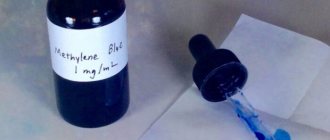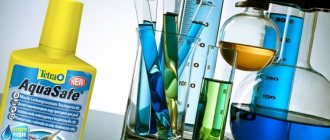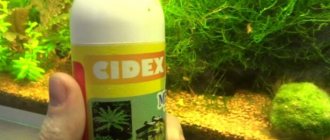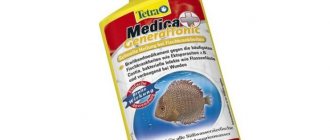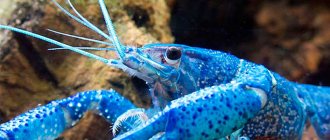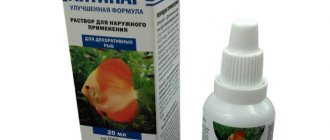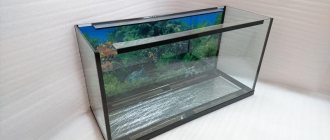We are all afraid of a new infection. Vaccinated and not vaccinated. And even those who are not vaccinated on principle. Those who wear masks and those who don't. There are already well-developed treatment methods, but their effectiveness, to put it mildly, is not very good, at least in my subjective opinion. And then, quite by accident, I came across news from last year, which stated that scientists from Sechenov University had discovered the effectiveness of methylene blue in the treatment of coronavirus.
First of all, I asked the opinion of a doctor I know, who is intensively fighting Covid in our city, and before that he fought in other cities (works in Covid hospitals). In response I heard caustic ridicule. Well, okay, I agree, it sounds like nonsense, but I still decided to find more information, because there is no smoke without fire. This is how I got to the website of this university and more. University scientists write that improvements appear the very next day! How could this not be of interest? I searched on the foreign Internet. But, since I am far from medicine, I did not understand everything, and I could easily have understood something incorrectly.
Please, if you have any additional information or personal experience on this issue, please share. In the meantime, to the point...
Composition, release form
Methylene Blue - In Latin, Methylenum coeruleum is a dye. Other names for this substance are known: Methylene blue, Methyl blue. When dry, it appears as dark green crystals with a characteristic bronze luster. The active ingredient is methylthioninium chloride.
The drug is used mainly in the form of an alcohol solution. It contains alcohol and methylene blue itself. A weaker aqueous solution may be used. Its composition is represented by Methyl blue and purified water.
A special solution is prepared for intravenous administration. Its dominant component is Methylene blue (solution with a concentration of 1%). Glucose (25%) is used as another active ingredient. Additional components are also included - stabilizer and prolongator.
The main form of release of the alcohol preparation is glass bottles with a solution with a concentration of 1%. Their average volumes are 10-15 ml.
Methylene blue
Aqueous ready-made solutions of Methylenum coeruleum are produced in glass bottles of 10, 25, and 50, 100 ml. A special solution is intended for intravenous administration, contained in ampoules of 20-50 ml.
Instructions for use
To remove pathogenic parasites from the aquarium or carry out prevention, you need to add blue conditioner to the water at the rate of 1 drop/2.5 liters of liquid. You cannot drop the product directly into the water: the drug is first mixed in 100 ml of water, and then the prepared mixture is carefully poured into the aquarium in a thin stream. After a while, it is necessary to perform a partial water change and, if necessary, repeat the procedure, leaving the fish to swim in the aquarium with blue water for five days. After completion of treatment, the liquid in the reservoir is filtered through a carbon filter, or completely renewed.
If methylene blue is used for a marine aquarium, the following procedure must be followed:
- In a separate container, stir the blue solution at the rate of 1 ml/10 l of water.
- Patients in their care are removed from the common tank into a separate container with medicine.
- Treatment should last at least 3 hours, the procedure must be repeated every other day. The total number of treatments is 5.
To process and improve the development of eggs, experienced aquarists proceed as follows:
- The eggs are placed in a container with a blue solution for 2-3 hours.
- The dosage for preparing the solution is 1 ml/50 l of liquid.
The recommended dosage of the drug should be carefully observed, since if it is exceeded, there is a risk of killing the fish offspring.
Mechanism of action
The effectiveness of Methylene blue, which is a representative of the group of antiseptics, is explained by its rapid destructive effect on harmful pathogenic microflora.
The basic mechanism of action of the drug is due to the activity of its components. They are able to bind bacterial proteins upon contact and then remove them almost instantly.
Pathogenic microorganisms die as a result of such interaction, which prevents the risk of their penetration into the skin tissue. The active ingredients of an antiseptic solution, when applied externally, are not able to enter the bloodstream, so they are not absorbed by the body.
An alcohol solution produces an antiviral, disinfectant, antimicrobial, analgesic, antibacterial effect, and also helps accelerate the regeneration of damaged skin tissue. The aqueous analogue is used as a fast-acting antidote.
The instructions for the drug indicate that it can be used for diagnostic purposes to study kidney function, since after internal use of the drug, the urine turns blue.
The substance is excreted in urine and bile mainly in an uncolored form, although it is possible that some amount may be excreted unchanged.
Precautionary measures
Methylene blue is a medicinal product, so when working with it you must follow safety precautions:
- Wear rubber gloves and avoid contact of the solution with bare skin and mucous membranes.
- It is prohibited to ingest the solution, smoke or eat during the procedures.
- After completing the treatment, the containers in which the solution was located are thoroughly washed.
- Empty bluing containers are disposed of.
Important information: blue should not be used in aquariums where large amounts of nitrogen compounds are present.
Methylene blue is an excellent and effective remedy that allows aquarists to properly care for their fish and promptly eliminate dangerous diseases. When using the product, it is important to adhere to the instructions for use and follow the recommended dosage.
Indications for use
Methylene blue has a wide range of applications with high disinfecting and disinfecting effectiveness.
This product in the form of solutions has the following indications:
- pharyngitis;
- stomatitis;
- gingivitis;
- follicular tonsillitis;
- thrush;
- laryngitis;
- caries;
- pyoderma;
- minor thermal burns;
- sycosis;
- aphthoses of the mucous membranes;
- herpes;
- wounds;
- eczema;
- furunculosis;
- insect bites;
- urethritis;
- cystitis;
- intoxication.
An aqueous solution for external treatment of mucous membranes and skin is permitted from the age of 1 year.
Description of the drug
Methylene blue aquarium as an effective disinfectant. It is used to clean the aquarium from parasites , as well as to treat fish before stocking. Methylene blue is also used for preventive purposes against various diseases.
The popularity of the drug is associated with its advantages in aquarium farming. These include:
- fungus control;
- strengthening the immune system of fish;
- acceleration of metabolic processes, due to which tissue respiration is supported;
- improvement of the spawning process;
- positive effect on fish, providing a calming effect;
- fight against unicellular microorganisms.
Methylene blue can also be added to feed
Note! Methylene blue can also be added to food, as many aquarium pets tolerate the drug well.
Contraindications and side effects
Methylene blue is a drug with a minimal list of contraindications. For external use, its use is prohibited if an allergic reaction is detected and in children under 1 year of age. When treating mucous membranes, the solution is applied only to problem areas.
The following conditions are prohibited for internal use of the drug:
- renal failure;
- lactation period;
- pregnancy;
- manifestation of individual intolerance.
In rare cases, side effects are possible:
- nausea;
- pain in the abdominal area;
- anemia;
- allergic rash;
- swelling;
- burns of mucous membranes.
It is advisable to check the body's reaction to the drug before starting treatment with Methylene blue. You can go to a medical institution to see an allergist who will do the necessary testing.
Update:
Quote from comment:
Blue is a photosensitizer. When irradiated, it activates molecular oxygen, which is always present in the cell, and turns it into a killer. There is no need for a spotlight here if the sensitizer is sensitive enough. The main problem is that activated (singlet) oxygen destroys everything around it. It doesn’t matter to him whether the cell is healthy or sick, or whether it’s even a virus. Roughly speaking, he breaks the first chemical bonds he comes across and generates a mass of other active particles (radicals). Radiation exposure works in exactly the same way. Actually, in oncology, both photodynamic therapy and radiotherapy are used in a similar way: a strictly defined location (tumor) is irradiated. Now do you understand what will happen if you simply irradiate the “nasopharynx and chest area”?
Dilution of Methylene Blue
A crystalline preparation of Methyl blue is more accessible. It is stored in a tightly closed glass container.
Dilution sequence for Methylene blue:
- If you want to make the most commonly used aqueous solution of the drug, having a concentration of 1%, measure out 10 g of powder.
- Pour 1 liter of boiling water cooled to warm into a glass container.
- Pour the prepared powder into it while vigorously kneading with a wooden spatula.
- When all the crystals have dissolved, strain the solution into another glass vessel using a gauze cloth folded in 6 layers.
During work, protect your hands with rubber gloves to avoid staining the skin.
Therapeutic baths
Blue baths are good because they contain a high concentration of the drug, which makes it possible to eliminate diseases in a short time. The procedure is performed once for mildly affected fish, or twice with an interval of 2-3 days for a severe stage.
To prepare a therapeutic bath, settled water of a suitable temperature is poured into a separate container, after which the liquid is filled with oxygen using an aerator. Blue is added at the rate of 1.5 ml/1 liter of water, thoroughly stirring the product until the water turns blue. The length of time the fish stays in the bath is 30 minutes.
Instructions and doses
Methylene blue is an effective antiseptic used for a variety of diseases.
Thrush, aphthous stomatitis
Use a one percent aqueous solution, soak a cotton swab with it, and carefully treat each sore spot. Before starting the procedure, it is necessary to dry the oral cavity from saliva with a sterile cotton swab.
For adults, the session is practiced every 3-4 hours. For children over one year of age, the treatment is carried out 3-4 times a day, timing the procedure after meals. If the child is breastfed, the mother’s nipples should be lubricated with the solution, which will protect the baby’s mucous membranes from possible damage.
Stomatitis caused by herpes
When rashes appear due to exacerbation of herpes, the blisters located on the mucous membranes in the mouth and the inside of the lips are treated three times a day with an aqueous solution of Methyl Blue. The skin area around the lip border is lubricated from the outside with an alcohol analogue, covering the healthy area next to the rash.
When large lesions appear, adults are advised to rinse their mouths with an aqueous solution in the morning and evening.
The effectiveness of Methylene blue for stomatitis of various natures is manifested in several directions:
- disinfection and drying of painful, weeping ulcers;
- slowing down the development of pathogenic bacteria;
- healing of microcracks;
- elimination of inflammatory foci and purulent processes.
After completing the procedures involving the application of Methyl Blue to the internal surfaces of the oral cavity, it is not recommended to consume food or drinks for 30-40 minutes. During the entire treatment course, spicy, hot, overly sour foods, which can further irritate the affected oral mucosa, are excluded from the menu.
With systematic use of the drug, healing of painful ulcers is observed 3-4 days after the start of treatment. Patients experience relief after 2-3 procedures.
Wounds, burns
If skin lesions are detected, it is recommended to use an alcohol solution based on Methylene blue, which has pronounced antiseptic and disinfecting properties.
The affected area of skin is carefully washed with cool, pre-boiled water. Soak a cotton swab in the preparation and carefully apply it to the affected area. Repeat treatment sessions 3-4 times a day.
Staphylococcus
When ulcers appear on the skin caused by the development of Staphylococcus aureus, an alcohol-based solution of Methylene blue is successfully used to treat the affected areas. Soak a cotton swab with the product and distribute it generously onto each purulent formation. Sessions are practiced 3-4 times a day. The alcohol composition is not used on mucous membranes.
Table. Methylene Blue Dosages:
| Disease | Solution concentration | Application |
| Cystitis, urethritis | An aqueous solution with a concentration of 0.02% is required. The powder dissolves in filtered water in a ratio of 1:5000. | The male urethra is washed using a special catheter. Women with cystitis are recommended to rinse the vagina using a syringe. |
| Pharyngitis, laryngitis, sore throat | Prepare an aqueous solution of Methylene blue. The recommended concentration is 0.02%. | They practice gargling a sore throat three times a day. |
| Caries | In order to prevent and reduce the rate of caries development, a weak solution of the drug is used - 0.02%. | At the first signs of caries development, in the morning and evening, rinse teeth with a disinfecting solution for 2-3 minutes. |
| Gingivitis | You will need a one percent ready-made aqueous solution. | Gums affected by the inflammatory process must be lubricated with the drug three times a day. |
| Poisoning caused by carbon monoxide, dangerous cyanides, hydrogen sulfide. | A water-based Methyl Blue preparation is used with a concentration of 1%. | The healing ready-made solution is used intravenously in a medical facility, 50-100 ml. |
| Poisoning with nitrites, toxic methemoglobin-forming substances, aniline, as well as derivatives of this organic compound. | An aqueous one percent solution of the drug is shown. | For intravenous administration, it is calculated that for every 1 kg of weight, 0.1-0.15 ml of solution will be required. |
Coloring
When using Methyl Blue, a slight bluish tint to the mucous membranes or skin may occur, which is not dangerous. When the concentration is properly selected, the drug does not have a toxic effect .
After cessation of treatment, after a few days the skin acquires its natural color.
Effect of methylene blue on human sperm motility in vitro
Evdokimov V.V., Isaev N.K., Turovetsky V.B., Pirutin S.K.
Information about authors:
- Evdokimov V.V. – Doctor of Medical Sciences, Ch. Researcher, Department of Andrology and Human Reproduction, Research Institute of Urology and Interventional Radiology named after N.A. Lopatkina - branch of the Federal State Budgetary Institution "National Medical Research Center of Radiology" of the Ministry of Health of Russia, [email protected] mail.ru. AuthorID 543052
- Isaev N.K. – Doctor of Biology, Leading Researcher, Faculty of Bioengineering and Bioinformatics, Moscow State University. M.V. Lomonosov, Moscow,; AuthorID 89160
- Turovetsky V.B. – Ph.D., senior researcher at Moscow State University. M.V. Lomonosov, Faculty of Biology, [email protected] , AuthorID 85978
- Pirutin S.K. – Ph.D., senior researcher at Moscow State University named after M.V. Lomonosov, Faculty of Biology, Pirutin, AuthorID 91321
Currently, the demographic situation in the country is characterized by a falling birth rate. This trend, according to demographers, will continue for several years. According to WHO, the percentage of infertile marriages in different countries reaches 10-15% of the total number of married couples. In the Russian Federation, according to the National Medical Research Center for Obstetrics, Gynecology and Perinatology named after. IN AND. Kulakov, this number is 17%, and more than 4 million men are diagnosed with infertility of various forms [1-3].
In recent years, reproductive dysfunction in men has been of particular medical and social significance due to the progressive decline in the fertile properties of sperm [4,5]. Fertility disorders are considered as a multifactorial condition that can be mediated by the presence of pathological changes in the organs of the reproductive system (varicocele, prostatitis, sexually transmitted infections, cryptorchidism, hypogonadism, etc.), as well as the influence of external factors (smoking, alcohol, physical inactivity, obesity , electromagnetic radiation from various sources, unfavorable environmental factors, occupational hazards) [6]. These effects may simultaneously increase changes in reproductive function and cause hormonal imbalances. In all likelihood, the combination of these factors leads to a high percentage of idiopathic infertility, reaching 30-50% in the structure of male infertility, which causes not only the difficulty of diagnosis, but also the choice of treatment tactics for identified disorders [7].
Until now, treatment and diagnosis of male infertility remain ineffective; correction of male fertility disorders does not always lead to positive results. In this case, to normalize the structural and functional state of male germ cells, hormonal drugs, vitamins, microelements, antioxidants, etc. are used. However, the effect of such treatment does not always satisfy both the patient and the doctor. Therefore, one of the urgent tasks of modern andrology is the search for agents that can increase sperm motility, as well as increase their resistance to damaging factors of various natures.
Previously, we carried out a number of experiments aimed at finding ways to increase male fertility by increasing sperm motility using regulatory peptides [8] or a protein-peptide complex (PPC) obtained from bovine testes. [9]. Studies have shown that regulatory peptides and BOD preparations had a pronounced ability to increase both active and overall sperm motility.
Subsequently, an analysis of the literature indicated the possibility of using methylene blue (MB) as an agent influencing the functional activity of sperm [10,11]. We hypothesized that it is possible to increase sperm motility with the help of substances that can directly affect the functioning of mitochondria, one of such agents is methylene blue. A number of studies have noted a positive effect of exposure to methylene blue, where the development of cellular damage is associated with disruption of mitochondrial functions [12]. Currently, MS is used in medicine as an antiseptic and for the treatment of methemoglobinemia, vasoplegic syndrome and phosphamide neurotoxicity. Moreover, neuroprotective properties of MS have been demonstrated in models of stroke, Alzheimer’s and Parkinson’s diseases [13, 14]. The authors attribute the protective effect to the fact that MS enhances autophagy, reduces cerebral edema, and also inhibits microglial activation and reduces inflammation. It should be noted that chemically this substance is a tricyclic phenothiazine [15] and in mitochondria can act as a catalyst for the redox cycle.
M. Oz et al. demonstrated the effect of MS in an experiment. They showed that this drug is capable of reducing organ dysfunction in rats caused by exposure to a number of damaging factors. In vitro experiments have shown that MS effectively reduces the death of cultured neurons caused by paraquat or zinc ions, the toxic effect of which is directed towards mitochondria [14].
In connection with the above, the objective of this work is to study the biological effect of the drug methylene blue on the motility and viability of human sperm.
MATERIALS AND METHODS
The studies were carried out on human spermatozoa from ejaculate obtained in the generally accepted way. After liquefaction after 40-60 minutes, the ejaculate was microscoped in transmitted light at a magnification of x400 on an Amplival microscope (Karl Zeiss, Iena). Sperm motility and other ejaculate parameters were assessed according to the WHO standard, 5th edition [16]. The experiments were carried out at a temperature of 20–22ºС. From the resulting ejaculate sample, 1 ml was taken for experiment and control. The MS preparation was added to the test tube to a final concentration of 1 nM.
The results obtained are presented in the form of arithmetic average values of the studied parameters and their root-mean-square errors. The experimental results were processed statistically using the Student's t test. Differences between the arithmetic mean values of the parameters were considered significant at p<0.05.
RESEARCH RESULTS
We conducted a series of experiments with motile cells - sperm. In one series of experiments, ejaculate (13 patients) with initial low sperm motility was used (Table 1). Another series used ejaculate samples (10 patients) with initial normal sperm motility (Table 2). Sperm motility (total, active and low) was calculated as the content of motile cells in the ejaculate per 100 analyzed. Total mobility is the sum of active and low mobility fractions. The tables in brackets show the results relative to the initial level, taken as relative 100%.
With initial asthenozoospermia (Table 1), active mobility increased significantly in the first 30 minutes of the experiment, then decreased to the initial level. Low mobility after 2 hours of observation noticeably decreased, and overall mobility also, after some increase, fell to the initial level.
Table 1. The effect of methylene blue on sperm motility in the initial asthenozoospermia (total motility – less than 40% )
*differences in mobility values compared to the initial level are significant (p<0.05).
With normozoospermia (Table 2), active mobility changed significantly over 2 hours of observation. Low sperm motility changed less significantly during this period; overall motility increased significantly in the first 30 minutes, then decreased to the initial level. In this case, a more pronounced response of actively motile forms of sperm to the effect of the drug can be identified.
Table 2. The effect of methylene blue on sperm motility in the initial normozoospermia (total motility – less than 40% )
*differences in mobility values compared to the initial level are significant (p<0.05).
In control samples, mobility after 2 hours of observation in all cases remained at the original level.
The number of living forms of sperm during the experiment in both cases (astheno and normozoospermia) remained at the original level of 60 – 64%.
Thus, adding MS to the ejaculate within 30 – 60 minutes. incubation changed all forms of sperm motility to varying degrees. With increasing incubation time, the effect of increasing sperm motility was not observed.
DISCUSSION
The results of the study of the effect of MS on sperm with the leading form of pathospermia - asthenozoospermia - show the presence of significant changes in the main functional parameters of the ejaculate. The response of sperm to the effects of MS in different groups is different both in time and in effect. The most pronounced increase in motility was observed in the fraction of actively motile spermatozoa in the first 30–60 minutes of the experiment. After 2 hours, in all ejaculate samples, including the control, motility returned to its original level. After 24 hours of observation, all types of mobility decreased to 20-50% relative to the initial level, in the control - to 2-60%.
Currently, the mechanism of the restorative and stimulating effect of the drug on various cells is not completely clear, however, there are indications in the literature that these properties are to a certain extent associated with the effect on calcium homeostasis and the functional state of mitochondria [17,18].
It has been shown that MS is able to reduce organ dysfunction in rats as a result of exposure to a number of damaging factors. In vitro experiments have shown that MS effectively reduces the death of cultured neurons caused by paraquat or zinc ions, the toxic effect of which is aimed at mitochondria [19,20].
In addition, as is known, sperm motility is ensured by the energy of glycolysis, one of the enzymes of which is glyceraldehyde 3-phosphate dehydrogenase - GAPDH, which is tightly bound in the sperm to the fibrous layer of the flagellum [21]. According to the authors, sperm motility largely depends on the activity of this enzyme, which is very sensitive to the damaging effects of reactive oxygen species (ROS). This suggests that an increase in sperm motility can be achieved using a number of agents (including, possibly, some regulatory peptides) that reduce the increased production of ROS, which is observed in a number of urological diseases, including those of the urogenital system.
Thus, the conducted studies revealed the ability of MS to stimulate the motility of human spermatozoa in experiments. Although the mechanism of the observed effect remains unclear, the data obtained show the promise of further work to study the possibility of using the drug in andrological and reproductive practice.
LITERATURE
- Shcheplev P.A. Andrology. Clinical recommendations. M., Medical practice. 2007. 154 p. (Scheplev PA Andrology. Clinical recommendations. M., medical practice. 2007.154 s.)
- Kulakov V.I. Assisted reproductive technologies present and future. M. Medical information agency. 2005. pp. 11-15. (Kulakov VI Assisted reproductive technologies present and future. M. Medical news. 2005.P. 11-15.)
- Pashkova E.Yu., Kalinchenko S.Yu. Male infertility in the 21st century - realities and prospects. Effective pharmacotherapy. Urology and Nephrology 2013;(1): 26-32. (Pashkova E.Yu., Kalinchenko S.Yu. Male infertility in the 21st century realities and prospects. Effective pharmacotherapy. Urology and Nephrology 2013; (1): 26-32.)
- Vinogradov I.V., Gablia M.Yu. The role of the male factor in the analysis of failures in ART protocols. URL: https://uronews.ru/2012/10/vliyanie-muzhskogo-faktora-na-veroyatnostneudachi-v-protokole-vrt/. (Vinogradov IV, Gabliya M.Yu. e role of the male factor in the analysis of failures in ART protocols. URL: https://uronews.ru/2012/10/vliyanie-muzhskogofaktora-na-veroyatnost-neudachi-v -protokole-vrt/)
- Ovchinnikov R.I., Gamidov S.I. The causes of reproductive losses in men are fragmentation of sperm DNA. RMJ 2015;(11):634-638. (Ovchinnikov RI, Hamidov SI The causes of reproductive loss in men are sperm DNA fragmentation. RMJ 2015; (11): 634-638.)
- Bykov V.L. Spermatogenesis in men at the end of the twentieth century (literature review). Reproduction Problems 2000;(1): 6-13. (Bykov VL Spermatogenesis in men at the end of the twentieth century (literature review). Reproduction Problems 2000; (1): 6-13.)
- Kellet E.P., Korneeva I.E., Shurshalina A.V. Infertility of unknown origin: the focus of modern scientific research. Problems of Reproduction 2010;(1): 32-35. (Kellat EP, Korneeva IE, Shurshalina AV Infertility of unknown origin: the focus of modern scientific research. Reproduction Issues 2010; (1): 32-35.)
- Evdokimov V.V., Zakharikov S.V., Andreeva L.A., Myasoedov N.F., Turovetsky V.B. Effect of regulatory peptides on human sperm motility in vitro. Experimental and Clinical Urology 2016;(2):67–69. (Evdokimov VV, Zakharikov SV, Andreeva LA, Myasoedov NF, Turovetsky VB e effect of regulatory peptides on in vitro human sperm motility. Experimental and clinical urology 2016; (2): 67–69.)
- Yamskova V.P., Krasnov M.S., Yamskov I.A. New experimental and theoretical aspects in bioregulation. The mechanism of action of membranotropic homeostatic tissue-specific bioregulators. Saarbucken. Lambert Academic Publishing, 2012. 127 pp. (Yamskova VP, Krasnov MS, Yamskov IA New experimental and theoretical aspects in bioregulation. The mechanism of action of membranotropic homeostatic tissue-specific bioregulators. Saarbucken Lambert Academic Publishing, 2012.127 p.)
- Wood BL, Doncel GF, Reddy PR, Sokal DC. Effect of diltiazem and methylene blue on human sperm motility, viability and cervical mucus penetration: potential use as vas irrigants at the time of vasectomy. Contraception 2003;67(3):241-5.
- Chandler JE, Harrison CM, Canal AM. Spermatozoal methylene blue reduction: an indicator of mitochondrial function and its correlation with motility. Theriogenology 2000;15;54(2):261-71.
- Wainwright M, Amaral L. The phenothiazinium chromophore and the evolution of antimalarial drugs. Trop Med Int Health 2005;10(6):501–511. doi: 10.1111/j.1365-3156.2005.01417.x
- Watts LT, Lloyd R, Garling, RJ Stroke neuroprotection: targeting mitochondria. Brain Sci 2013;3(2):540-560. doi: 10.3390/brainsci3020540.
- Oz M, Lorke DE, Petroianu GA. Methylene blue and Alzheimer's disease. Biochem Pharmacol 2009. 78, 927-932.
- Stelmashuk E.V., Genrikhs E.E., Mukhaleva E.V., Skrebitsky V.G., Isaev N.L. Neuroprotective effect of methylene blue in vivo and in vitro. Bulletin of Experimental Biology and Medicine 2019;167(4): 438-443. (Stelmashuk EV, Genrikhs EE, Mukhaleva EV, Skrebitsky VG, Isaev NL Neuroprotective effect of methylene blue in vivo and in vitro. Bulletin of experimental biology and medicine 2019; 167 (4): 438-443.)
- WHO guidelines for the examination and processing of human ejaculate. 5th ed. 2012, M.: 291 p. (WHO guidelines for the study and treatment of human ejaculate. 5th ed. 2012, M .: 291 p.)
- Poteet E, Winters A, Yan LJ, Yang SH. Neuroprotective action of methylene blue and its derivatives. PLoS One 2012;7(10):e48279. doi: 10.1371/journal.pone.0048279.
- Zhao M, Liang F, Xu H, Yan W, Zhang J. Methylene blue exercises a neuroprotetive effect against traumatic brain injury by promoting autophagy and inhibiting microglial activation. Mol Med Rep 2016;13(1):13-20. doi: 10.3892/mmr.2015.4551
- Sharpley MS, Hirst J. The inhibition of mitochondrial complex1 (NADH:ubiquinone oxidoreductase) by Zn2+. J Biol Chem 2006;281(46):34800-9.
- Suh SW, Chen JW, Motamedi M, Bell B, Listiak K, Pons NF, et al. Evidence that synaptically – released zinc contributes to neuronal injury after traumatic brain injury. Brain Res 2000;852(2):268-273.
- Shutskaya Yu.Yu., Elkina Yu.L., Muronets V.I. Study of glyceraldehyde-3phosphate dehydrogenase from human spermatozoa. Biochemistry 2008;73(2):228-236. (Shutskaya Yu.Yu., Elkina Yu.L., Muronets VI The study of glyceraldehyde 3-phosphate dehydrogenase from human sperm. Biochemistry 2008; 73 (2): 228-236.)
The article was published in the journal “Experimental and Clinical Urology” No. 3 2021, pp. 50-53
Topics and tags
Male infertility
Magazine
Journal "Experimental and Clinical Urology" Issue No. 3, 2019
Comments
To post comments you must log in or register
Substitutes
If necessary, you can select products from the pharmacy chain that are similar in healing characteristics to Methylene blue.
Table. Substitutes for Methyl Blue:
| Name of the drug | a brief description of |
| Antisept | The drug demonstrates pronounced disinfectant and antiseptic qualities. Recommended for treating skin. |
| Askosept | Has a beneficial anti-inflammatory effect in pharyngitis, laryngitis. |
| Biosept | Belongs to the group of strong antiseptics used to disinfect the skin and treat purulent lesions. |
| Diamond green | It is one of the most common antiseptics that effectively treats a variety of skin lesions. |
| Vitafarm | When used externally, it effectively disinfects the skin. Has bactericidal and antiviral effects. |
| Hydroperite | The active ingredient of this strong antiseptic is urea peroxide. Treats sore throat, stomatitis, wounds. |
| Potassium permanganate | A similar antiseptic with strong oxidizing properties is used in urology, gynecology, and for the treatment of skin lesions. |
| Kutasept | This disinfectant solution has bactericidal, fungicidal, antiviral characteristics. |
| Medasept | It has a pronounced disinfectant and antiseptic effect. |
| Sodium tetraborate | It is highly effective against candidiasis, having bacteriostatic activity. |
| Hydrogen peroxide | This common antiseptic belongs to the group of antioxidants with a hemostatic effect. |
| Septile Plus | The active component of the drug is ethanol. When used externally, it has a detrimental effect on both bacteria and viruses. |
| Pharmasept | Disinfects and disinfects the skin. |
| Chlorophyllin | Effectively treats sore throat, purulent wounds, burns. |
Compatibility with other drugs
The combined use of FMC with other drugs in some cases can increase the effectiveness of treatment.
The use of furazolidone increases the therapeutic effect in the fight against trichodinosis, costiosis, and ichthyophthyriosis. Recovery occurs faster.
For the treatment of severe chylodonellosis, it is advisable to use it together with chloramphenicol.
It is not recommended to combine FMC with preparations of copper and other metals, because the toxic effect on the skin and gills increases.
Cannot be used simultaneously with other antiparasitic agents. If they contain similar components, an overdose may occur. As a result, aquarium fish may die.
Storage conditions and periods
At home, it is recommended to keep the bottle with the prepared Methyl Blue solution in a dark place at temperatures up to 25 °C.
The maximum shelf life of alcohol products is 2 years. For the aqueous version of the drug, this figure is half as much.
Ready-made dosage forms after opening the vials are allowed to be used for 10-12 days.
Recognized in alternative medicine, Methylene blue is an antiseptic that helps in the treatment of stomatitis of various natures, skin lesions, herpes, and inflammatory processes.
Use in a community aquarium
In a community aquarium, methyl blue is used if there is an outbreak of disease and all fish need to be treated. In this situation, the reservoir water should also be disinfected. When used in a general aquarium, take into account some of the features of using the product. When used, light decorative elements are immediately removed from the aquarium. You should pour blue into the aquarium after diluting it with water. Methylene blue is added to water at the rate of 0.5 ml/1 l. The antiseptic is dissolved in 300 ml of water and the composition is divided into 3 parts. After pouring 1 part of the solution into the aquarium, turn on aeration, which speeds up the process of distributing the drug in the water.
After 20 minutes, pour in the second portion and after another 30 minutes, the third. The water in the aquarium becomes a uniform blue color without losing its transparency. After applying the product, the fish should not be nervous or in any way visibly react to the medicine. Changes in behavior indicate that the concentration of the product is too high, and to restore the pets to normal condition, it is necessary to change some of the water. 5 days after adding the drug, replace half the water in the aquarium and add the product again.
The course of treatment with blue lasts 30 days. After its completion, an activated carbon filter is used to remove the blue color from the water. It copes with the consequences of using an antiseptic in 1-2 days. Using blueing allows you to avoid problems with fish and keep your aquarium in good condition, but only if the instructions for use are followed.
Interesting videos about methylene blue
AdminAuthor of the article
Did you like the article?
Share with your friends:
